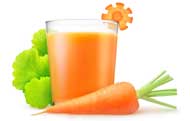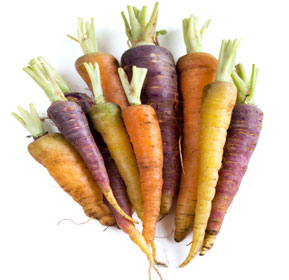





1. Carrot Facts
2. Types of Carrots (Australia)
3. Carrot Nutritional Value
4. Carrot Health Benefits
The cultivated carrot (Daucus carota subsp. sativus) is a root vegetable of the Umbelliferae family, usually orange in colour, though purple, red, white, and yellow varieties exist.
History and Origin
The earliest vegetable definitely known to be a carrot dates from the 10th century in Persia and Asia Minor and would have been quite unlike the orange rooted carrot of today. It is considered that Carrots were originally purple or white with a thin root, then a mutant occurred which removed the purple pigmentation resulting in a new race of yellow carrots, from which orange carrots were subsequently developed.
- • Nantes varieties
- • Imperator varieties
- • Autumn King varieties
- • Chantenay varieties
Most of the carrot varieties grown in Australia belong to one of the following four variety groups distinguished by shape although some new varieties, such as Mojo are the result of combining characteristics from several variety groups via conventional plant breeding.
There are four major variety groups represented in Australia.
Nantes varieties
Nantes varieties with blunt-ended straight to slightly tapered roots. Nantes varieties are generally sweet flavoured because of low terpenoid contents. Root length averages 200 mm. Example variety are Stefano and Navarre.
Nantes varieties have become, by far, the most important type of carrot grown in Australia.
Imperator varieties
Imperator varieties such as Red Hot and Cellobunch which produce pointed roots up to 350 mm long with medium width shoulders and taper. Several varieties grown in Australia such as Condor and Red Brigade are intermediate in shape between Imperator and Autumn King varieties. Still others such as Red Count and Red Sabre are intermediate in shape between Imperator and Nantes. Imperator varieties originated in the United States in the 1920s from crossing Chantenay and Nantes varieties.
Autumn King varieties
Autumn King varieties which have wide-shouldered highly tapered pointed roots averaging 300 mm in length. The main representative of this group grown in Australia is Western Red. Majestic Red is a related variety with some Chantenay characteristics.
Chantenay varieties
Chantenay varieties such as Royal Chantenay which are wide-shouldered and highly tapered with good internal colour. They produce short roots and are mainly used for processing. More recently the Japanese Kuroda type carrots have been grown, principally in Tasmania for export to Japan. During the late 1990's.
Vegetables " Carrots " ( Nutritional value )
Nutritional value per 100 g
Carrots, cooked, boiled, drained, without salt
|
Nutrient ( Proximate's )
|
Unit
|
Value
|
Daily Value %
|
|
Energy
|
kcal
|
35
|
1.7%
|
|
Protein
|
g
|
0.76
|
1.5%
|
|
Total lipid (fat)
|
g
|
0.18
|
0.002%
|
|
Carbohydrate, by difference
|
g
|
8.22
|
2.9%
|
|
Fiber, total dietary
|
g
|
3.0
|
10.7%
|
|
Sugars, total
|
g
|
3.45
|
|
|
Minerals
|
|||
|
Calcium, Ca
|
mg
|
30
|
2.3%
|
|
Iron, Fe
|
mg
|
0.34
|
1.8%
|
|
Magnesium, Mg
|
mg
|
10
|
2.3%
|
|
Phosphorus, P
|
mg
|
30
|
2.4%
|
|
Potassium, K
|
mg
|
235
|
5%
|
|
Sodium, Na
|
mg
|
58
|
2.5%
|
|
Zinc, Zn
|
mg
|
0.20
|
1.8%
|
|
Copper, Cu
|
mg
|
0.017
|
1.8%
|
|
Manganese, Mn
|
mg
|
0.155
|
6.7%
|
|
Selenium, Se
|
mcg
|
0.7
|
1.2%
|
|
Fluoride, F
|
mcg
|
47.5
|
|
|
Vitamins
|
|||
|
Vitamin C, total ascorbic acid
|
mg
|
3.6
|
4%
|
|
Thiamin (B-1)
|
mg
|
0.066
|
5.5%
|
|
Riboflavin (B-2)
|
mg
|
0.044
|
3.3%
|
|
Niacin NE (niacin) (B-3)
|
mg
|
0.645
|
4%
|
|
Pantothenic acid (B-5)
|
mg
|
0.232
|
4.6%
|
|
Vitamin B-6
|
mg
|
0.153
|
9%
|
|
Folate DFE (dietary folate) (B-9)
|
mcg
|
14
|
3.5%
|
|
Vitamin B-12
|
mcg
|
0.00
|
|
|
Vitamin A, RAE (retinol)
|
mcg
|
852
|
94.6%
|
|
Vitamin E (alpha-tocopherol)
|
mg
|
1.03
|
6.8%
|
|
Vitamin D (D2 + D3)
|
mcg
|
0
|
|
|
Vitamin K (phylloquinone)
|
mcg
|
13.7
|
11.4%
|
|
Lipids
|
|||
|
Saturated Fatty Acids
|
g
|
0.030
|
|
|
Monounsaturated Fatty Acids
|
g
|
0.006
|
|
|
Polyunsaturated Fatty Acids
|
g
|
0.089
|
|
|
Trans Fatty Acids
|
g
|
0.000
|
|
|
Carotenoids
|
|||
|
Beta-Carotene
|
mcg
|
8332
|
|
|
Alpha-Carotene
|
mcg
|
3776
|
|
|
Lutein + zeaxanthin
|
mcg
|
687
|
|

|
Reference Values are based on a 2,000 Calorie Intake, for Adults and Children 4 or More Years of Age. Your daily values may be higher or lower depending on your calorie needs.
|
|
|
Percentages are roughly approximated using (RDA) Recommended Dietary Allowances for adults. Source: USDA United States Department of Agriculture
|
|
|
Reference Values for Nutrition - FDA U.S. Food and Drug Administration
|
Carrot Nutritional Value
Carrots are rich in Beta carotene which is a powerful antioxidant which helps in maintaining a healthy skin and also keep one away from many diseases.
Benefits include;
• Carrots contain a phyto-nutrient called falcarinol which helps in promoting colon health and a reducing the risk of cancers.
• Consuming Carrots regularly can improve the appearance of skin, hair, nails etc and also improve eyes health.
• Carrots are rich in Carotenoids which are beneficial to blood sugar regulation.
Carrots are nutritional heroes, they store a goldmine of nutrients. Few other vegetables or fruit contain as much carotene as carrots, which the body converts to vitamin A. This is a truly versatile vegetable and an excellent source of vitamins B and C as well as calcium pectate, an extraordinary pectin fibre that has been found to have cholesterol-lowering properties. The high level of beta-carotene is very important and gives carrots their distinctive orange colour.
Carrot can enhance the quality of breast milk. It can improve the appearance of the skin, hair and nails. When taken daily it can lower cholesterol and blood pressure. Raw carrot contains beta-carotene, a strong antioxidant that can prevent cancer. Carrot juice when taken every day prevents bodily infections and is claimed to be valuable for the adrenal glands (the small endocrine glands situated above the kidneys).
Carrot can help improve eye health. Carrot can help increase menstrual flow. Carrot can regulate blood sugar. Carrot can promote colon health, because it is rich in fibre.
It is believed that the vitamins and minerals in carrots can help with obesity, poisoning of the blood, gum disease, insomnia, inflamed kidney, liver, gallbladder, Alzheimer’s disease, colitis, ulcer and painful urination.
Carrots are one of the richest sources of Vitamin A. Carotene present in this vegetable gets converted into Vitamin A by our body. It is indeed amazing that a mere 100grams of carrot supplies around 11,000 milligrams of vitamin A. Other major minerals present in carrot include sulphur, phosphorous and magnesium. The three minerals calcium, phosphorus and magnesium are essential for ensuring the strength of bones. Phosphorus is essential for the health of skin, hair and nerves. The vital magnesium content present in fresh carrot enables mental development, digestion of fats and the metabolism of mineral salts such as calcium, phosphorus, sodium, and potassium.
Sulphur also forms a major ingredient of insulin, the hormonal function of which is to convert carbohydrates into energy. Chlorine can be present in carrot from the processing method, this element is vital for the proper functioning of liver. Provides a cleansing and antiseptic effect on the digestive and circulatory systems.
Another nutrient in carrot, which deserves mention is Vitamin E, the muscle vitamin. It promotes the efficiency of the entire muscular system by the effective utilisation of oxygen.
- PROTECTS FROM CANCER
(Beta-carotene) - PROTECTS AGAINST MACULAR DEGENERATION
(Beta-carotene) - LOWERS BLOOD PRESSURE
(Potassium) - BONE STRENGTHENER
(Calcium, phosphorus and magnesium) - FIGHTS DIABETES
(Presence of carotenoids)

- CLEANSES THE BODY - COLON
(Rich in fibre) - IMPROVES EYESIGHT
(Vitamin A) - IMMUNE BOOSTER
(Rich source of Vitamin C) - HAS CARDIOVASCULAR BENEFITS
(Antioxidant richness) - HEALTHY SKIN, HAIR AND NERVES
(Phosphorus & Vitamin C)
References
|
World Carrot Museum - It is a virtual museum whose mission is to educate, inform and amuse visitors through the collection, preservation, interpretation and exhibition of objects relating to the Carrot.
|
|
Varieties and History of carrots in Australia - World Carrot Museum
|
|
Reference Values for Nutrition - FDA U.S. Food and Drug Administration
|
|
Nutritional Value of Carrot - USDA United States Department of Agriculture
|
